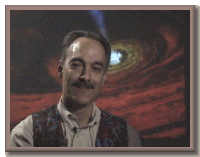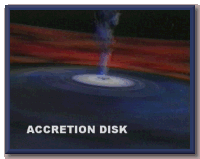|
|
Let's take a trip to a black hole, with Mike Garcia as our guide, and get to know its features close up. |
|
So imagine if you were able... if you could travel to one of these black hole systems that we have been studying now with Chandra. They are binary star systems. They are two stars which orbit each other. One of the stars is very much like our Sun and the other star is a black hole or a neutron star and they orbit each other and they are in a very tight orbit. Imagine, you know, something as big as the Sun and it's whipping around, and it is just whipping around very, very fast around this black hole in the center. And the sun-like star would not be round: it would be distorted in shape. It would be shaped like an egg, with the point of the egg pointing towards the black hole. And that shape is caused by the gravity of a black hole pulling on that star. And that gravity is strong enough that it actually pulls matter off of the surface of the star and that matter falls down in towards the black hole. And it falls in a spiral and it forms a disk around it, an accretion disk, looks like a plate. And the matter is swirling around in this disk, just like in the tub, when you pull the plug out of the tub, it swirls around, and goes down the black hole. Mike Garcia Astrophysicist Harvard-Smithsonian Center for Astrophysics |
|
But if black holes emit no light, how do we know they're there?

